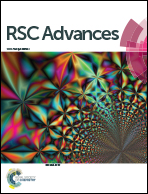Differential pulse stripping voltammetric determination of the antipsychotic medication olanzapine at a magnetic nano-composite with a core/shell structure†
Abstract
In this work, an electrochemical sensor based on Fe3O4@Ag core/shell magnetic nanoparticles (MNPs) was used to investigate the electrochemical behaviour of olanzapine. The synthesised Fe3O4@Ag core/shell MNPs were characterised by X-ray powder diffraction (XRD), transmission electron microscopy (TEM) and scanning electron microscopy (SEM). Fe3O4@Ag core/shell MNPs were used for modification of carbon paste electrode (CPE) and the nano-composite modified electrode (Fe3O4@Ag|CPE) was utilised for electrochemical investigation of olanzapine. Fe3O4@Ag|CPE led to an enhancement in electron transfer rate (ΔEp = 141 mV) and showed good electrocatalytic activity for oxidation of olanzapine. Fe3O4@Ag core/shell MNPs also led to a 5.4-fold enlarged effective electrode surface area. The proposed electrode showed good linearity between the anodic peak current and the concentration of olanzapine at two concentration ranges of 0.39–1.38 and 1.38–38.4 μmol L−1 and the detection limit was calculated to be 0.0018 μmol L−1. The modified electrode was used for determination of olanzapine in blood serum and plasma of schizophrenia patient.


 Please wait while we load your content...
Please wait while we load your content...